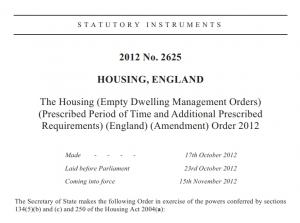



The fire at Grenfell House in Kensington and Chelsea has brought empty homes into the headlines, following Jeremy Corbyn’s call for unoccupied luxury flats in the borough to be requisitioned to ensure that survivors of the disaster can be housed locally.
When launching his proposal on 15th June, Corbyn explicitly situated it in the context of the supposed buy-to-leave phenomenon (which Corbyn inaccurately referred to as ‘land-banking’). He was reported to have said:
It can’t be acceptable that in London we have luxury buildings and luxury flats left empty as land banking for the future while the homeless and the poor look for somewhere to live. We have to address these issues.[1]
The proposal was widely reported in the press and Corbyn repeated his proposal on Sunday in an ITV interview with Robert Peston,[2] which has also received wide coverage. In this case he dropped in the idea of simply ‘occupying’ the empty homes, which was interpreted by some as a call for direct action a la Occupy movement, bringing predictable howls of outrage about Marxism and the end of civilization as we know it..[3]
A yougov poll in the wake of Corbyn’s comments showed 59% of respondent expressing some support for his proposal, with 28% opposed. Even amongst Conservative voters, the idea of requisitions received 40% approval. Again, the survey was couched in terms of ‘luxury flats’ rather than housing generally.[4]
Both Corbyn and close associates, such as John McDonnell,[5] have seemed to assume that there are legal mechanisms for ‘requisitioning’ the flats which are appropriate to current circumstances, when clearly there are not. Only the BBC seems so far to have examined the position under current legislation in any detail, rightly concluding that cost and time would militate against using current mechanisms.[6]
The BBC investigation did not, however, consider the relative ease with which the Empty Dwelling Management Order regime could be changed via a statutory instrument. For example, the three-month notice period (not mentioned by the BBC) was introduced by Eric Pickles using a Statutory Instrument, as was the stipulation that the home be empty for two years rather than the six months specified in the original primary legislation. These provisions could be changed. The BBC’s comment that the legislation is aimed at homes that are a nuisance is also incorrect, even following the changes introduced by Eric Pickles: there are no such criteria, only a procedural requirement that evidence about nuisance and community support be presented to the Tribunal considering the case.
It would be possible to demonstrate that the original intention of the legislation was simply to provide a route to bring back into use any homes that had been empty for over 6 months in order to meet housing need and Pickles’ attempts to narrow the application of the legislation could not over-ride the wish of Parliament should anyone wish to reverse his approach.
John McDonnell suggested that emergency legislation could be rushed through Parliament but the introduction of new primary legislation, with the development of appropriate criteria, of robust processes for evaluating the evidence to demonstrate that the criteria were met and the need for appropriate safeguards such as appeal processes would seem to make such a move more of a political gesture than an effective response to the immediate needs of those affected by the fire. Changes to the EDMO procedures, on the other hand, would allow a medium-term response, if adequately guided by the adage ‘act in haste, repent at leisure'. It is debatable, however, if such changes could really bring luxury flats into the frame at an affordable cost.
Meanwhile, the government has committed to rehousing all the survivors in the borough or neighbouring boroughs, though it is not clear how, or what rehousing would be temporary and what might be permanent. Alternatives do exist, for example:
- To contact all owners of second homes and empty homes in the borough inviting them to make their home available to survivors of the disaster. In the current spirit of national unity and ‘all being in this together’, which we understand prevails, this should produce a positive response; it is certainly capable of producing an immediate contribution, unlike many other solutions.
- To rehouse survivors in adequate-quality, temporary, prefabricated housing units on some part of the green space within the borough.
[1] http://www.telegraph.co.uk/news/2017/06/15/jeremy-corbyn-empty-homes-owned-rich-should-requisitioned-grenfell/ 16th June 207.
[2] http://www.itv.com/news/2017-06-18/jeremy-corbyn-renews-calls-to-seize-empty-homes-for-grenfell-tower-victims/
[3] See comments against the Telegraph news story at http://www.telegraph.co.uk/news/2017/06/18/jeremy-corbyn-calls-supporters-occupy-empty-homes-help-victims/
[4] https://yougov.co.uk/opi/surveys/results#/survey/c9858cf0-527a-11e7-86f0-4e52bfafa255/question/f7a01240-527a-11e7-bfce-be36d6dc7ab1/toplines
[5] e.g. in his Sky News interview with Sophie Ridge: https://www.youtube.com/watch?v=ryqx6GP8S6w
[7] For the most recent Empty Homes Network policy document see http://www.ehnetwork.org.uk/filling-empties-ehn-policy-position
